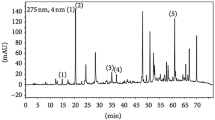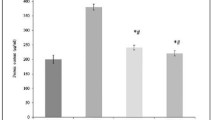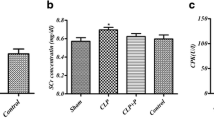Abstract
Sepsis is still a major cause of the high mortality rate in the intensive care unit. Many studies have been published about the severity of sepsis, but the cause of mortality in sepsis and multiorgan failure is still obscure. This study investigated the effects of caffeic acid phenethyl ester (CAPE) particularly on the inflammatory and related histopathological changes in the lung, liver and kidney in an experimental sepsis model. Forty Sprague Dawley rats were used in this study, and were divided into four groups of ten rats each, as follows: Group I was given intraperitoneal saline infusion treatment. Group II was given intraperitoneal CAPE infusion treatment. Sepsis was induced in the animals in Group III (sepsis with saline infusion), while Group IV rats underwent induced sepsis plus CAPE infusion treatment (sepsis with CAPE infusion). Sampling was performed 48 h after treatment. The induction of sepsis resulted in a significant increase in serum glucose, leukocytes, urea, creatinine, LDH levels in BAL, plasma MDA, AST and ALT levels in the sepsis + saline group. The use of CAPE significantly decreased these parameters. Histopathological examination revealed less congestion, portal inflammation, and focal necrosis of the liver, and less congestion, edema, and emphysematous and inflammatory changes in the lung in the sepsis + CAPE group than in the other groups. These results support that CAPE may be used for the treatment of organ failure during sepsis.



Similar content being viewed by others
References
Alberti, C., C. Brun-Buisson, H. Burchardi, et al. 2002. Epidemiology of sepsis and infection in ICU patients from an international multicenter cohort study. Intensive Care Med. 28:108–121.
Kirkeboen, K. A., and O. A. Strand. 1999. The role of nitric oxide in sepsis—an overview. Acta Anesthesiol. Scand. 43:275–288.
O’Reilly, M., D. E. Newcomb, and D. Remick. 1999. Endo-toxin, sepsis, and the primrose path. Shock 12:411–420.
Schröder, J., V. Khalke, K. H. Staubach, et al. 1998. Gender differences in human sepsis. Arch. Surg. 133:1200–1205.
Fiorentino, D., A. Zlotnik, T. Mosmann, et al. 1991. IL-10 inhibits cytokine production by activated macrophages. J. Immunol. 147:3815–3822.
Remick, D. G., G. R. Bolgos, J. Siddiqui, et al. 2002. Six at six: interleukin-6 measured 6 h after the initiation of sepsis predicts mortality over 3 days. Shock 17:463–467.
Tate, R. M., H. G. Morris, W. R. Schroeder, et al. 1984. Oxygen metabolites stimulate thromboxane production and vasoconstriction in isolated saline-perfused rabbit lung. J. Clin. Invest. 74:608.
Hotter, G., D. Closa, N. Prats, et al. 1997. Free radical enhancement promotes leukocytes recruitment through a PAF and LTB4 dependent mechanism. Free Radic. Biol. Med. 22:947–954.
İlhan, A., Ö. Akyol, A. Gürel, et al. 2004. Protective effects of caffeic acid phenethyl ester against experimental allergic encephalomyelitis-induced oxidative stress in rats. Free Radic. Biol. Med. 37:386–394.
Ozyurt, H., B. Ozyurt, K. Koca, et al. 2007. Caffeic acid phenethyl ester (CAPE) protects rat skeletal muscle against ischemia-reperfusion-induced oxidative stress. Vascul. Pharmacol. 47(2–3):108–112, Aug–Sep.
Turkyilmaz, S., E. Alhan, C. Ercin, et al. 2008. Effects of caffeic acid phenethyl ester on pancreatitis in rats. J. Surg. Res. 145(1):19–24. Epub 2007 Oct 29, Mar.
Song, Y. S., E. H. Park, G. M. Hur, et al. 2002. Caffeic acid phenethyl ester inhibits nitric oxide synthase gene expression and enzyme activity. Cancer Lett. 175:53–61.
Correa, P. B., J. A. Pancoto, G. R. de Oliveira-Pelegrin, et al. 2007. Participation of iNOS-derived NO in hypothalamic activation and vasopressin release during polymicrobial sepsis. J. Neuroimmunol. 183:17–25.
Nose, K., M. Wasa, and A. Okada. 2002. Gut glutamine metabolism at different stages of sepsis in rats. Surg. Today 32:695–700.
Yılmaz, H. R., E. Uz, N. Yücel, et al. 2004. Protective effect of caffeic acid phenetyl ester (CAPE) on lipid peroxidation and antioxidant enzymes in diabetic rat liver. J. Biochem. Mol. Toxicol. 18:234–238.
Aydoğdu, N., G. Atmaca, Ö. Yalçın, et al. 2004. Effects of caffeic acid phenethyl ester on glycerol-induced acute renal failure in rats. Clin. Experimental. Pharmacol. Physiol. 31:575–579.
Yağmurca, M., H. Erdoğan, M. Iraz, et al. 2004. Caffeic acid phenethyl ester as a protective agent against doxorubicin nephrotoxicity in rats. Clin. Chim. Acta. 348(1–2):27–34.
Sookhai, S., J. J. Wang, M. McCourt, et al. 2002. A novel therapeutic strategy for attenuating neutrophil-mediated lung injury in vivo. Ann. Surg. 235(2):285–291.
Sahna, E., H. Parlakpinar, F. Ozturk, et al. 2003. The protective effects of physiological and pharmacological concentrations of melatonin on renal ischemia-reperfusion injury in rats. Urol. Res. 31:188–193.
Ozveri, E. S., A. Bozkurt, G. Haklar, et al. 2001. Estrogens ameliorate remote organ inflammation induced by burn injury in rats. Inflamm. Res. 50:585–591.
Yu, M., D. Shao, R. Yang, et al. 2007. Effects of ketamine on pulmonary inflammatory responses and survival in rats exposed to polymicrobial sepsis. J. Pharm. Pharmaceut. Sci. 10:434–442.
Erikoğlu, M., M. Sahin, S. Ozer, et al. 2005. Effects of gender on the severity of sepsis. Surg. Today 35:467–472.
Bohles, H. 1997. Antioxidative vitamins in prematurely and maturely born infants. Int. J. Vit. Nutr. Res. 67:321–328.
Heller, A. R., G. Groth, S. C. Heller, et al. 2001. N-Acetylcysteine reduces respiratory burst but augments neutrophil phagocytosis in intensive care unit patients. Crit. Care Med. 29:272–276.
Grunberger, D., R. Banerjee, K. Eisinger, et al. 1988. Preferential cytotoxicity on tumor cells by caffeic acid phenethyl ester isolated from propolis. Experientia 44:230–232.
Sahin, O., O. Sulak, Y. Yavuz, et al. 2006. Lithium-induced lung toxicity in rats: the effect of caffeic acid phenethyl ester (CAPE). Pathology 38:58–62.
Su, Z. Z., D. Grunberger, and P. B. Fisher. 1991. Suppression of adenovirus type five EIA-mediated transformation and expression of the transformed phenotype by caffeic acid phenethyl ester (CAPE). Mol. Carcinog. 4:231–242.
Hosnuter, M., A. Gurel, O. Babuccu, et al. 2004. The effect of CAPE on lipid peroxidation and nitric oxide levels in the plasma of rats following thermal injury. Burns 30:121–125.
Sener, G., H. Toklu, C. Kapucu, et al. 2005. Melatonin protects against oxidative organ injury in a rat model of sepsis. Surg. Today. 35:52–59.
Brooks, H. F., C. K. Osabutey, R. F. Moss, et al. 2007. Caecal ligation and puncture in the rat mimics the pathophysiological changes in human sepsis and causes multi-organ dysfunction. Metab. Brain Dis. 22:353–373.
Galley, H. F., M. J. Davies, and N. R. Webster. 1996. Xanthine oxidase activity and free radical generation in patients with sepsis syndrome. Crit. Care Med. 24:1649–1653.
Irmak, M. K., E. Fadillioglu, M. Gulec, et al. 2002. Effects of electromagnetic radiation from a cellular telephone on the oxidant and antioxidant levels in rabbits. Cell. Biochem. Funct. 20:279–283.
Draper, H. H., and M. Hadley. 1990. Malondialdehyde determination as index of lipid peroxidation. Methods Enzymol. 186:421–431.
Razavi, H. M., R. Werhun, J. A. Scott, et al. 2002. Effects of inhaled nitric oxide in a mouse model of sepsis-induced acute lung injury. Crit. Care Med. 30:868–873.
Akyol, A., H. Ulusoy, M. Imamoglu, et al. 2006. Does propofol or caffeic acid phenethyl ester prevent lung injury after hindlimb ischaemia-reperfusion in ventilated rats? Injury 37:380–387.
Chen, M. F., P. C. Keng, P. Y. Lin, et al. 2005. Caffeic acid phenethyl ester decreases acute pneumonitis after irradition in vitro and in vivo. BMC Cancer 5:158, Dec 9.
Koksel, O., A. Ozdülger, L. Tamer, et al. 2006. Effects of caffeic acid phenethyl ester on lipopolysaccharide induced lung injury in rats. Pulm. Pharmacol. Ther. 19:90–95.
Ates, B., M. I. Doğru, M. Gül, et al. 2006. Protective role of caffeic acid phenethyl ester in the liver of rats exposed to cold stress. Fundam. Clin. Pharmacol. 20:283–289.
Iraz, M., E. Ozerol, M. Gulec, et al. 2006. Protective effect of caffeic acid phenethyl ester administration on cisplatin-induced oxidative damage to liver in rat. Cell. Biochem. Funct. 24:357–361.
Yılmaz, H. R., E. Uz, N. Yucel, et al. 2004. Protective effect of caffeic acid phenethyl ester on lipid peroxidation and antioxidant enzymes in diabetic rat liver. J. Biochem. Mol. Toxicol. 18:234–238.
Kuş, I., N. Colakoğlu, H. Pekmez, et al. 2004. Protective effects of caffeic acid phenethyl ester on carbon tetrachloride-induced hepatotoxicity in rats. Acta Histochem. 106:289–297.
Uz, E., F. Öktem, H. R. Yılmaz, et al. 2005. The activities of purine-catabolizing enzymes and the level of nitric oxide in rat kidneys subjected to methotrexate: protective effect of caffeic acid phenethyl ester. Mol. Cell. Biochem. 277:165–170.
Oktem, F., F. Ozguner, O. Sulak, et al. 2005. Lithium-induced renal toxicity in rats: protection by a novel antioxidant caffeic acid phenethyl ester. Mol. Cell. Biochem. 277:109–115.
Acknowledgement
The authors thank Dr. Fatih Kara for his excellent help in reviewing our statistical analysis.
Author information
Authors and Affiliations
Corresponding author
Rights and permissions
About this article
Cite this article
Tekin, A., Küçükkartallar, T., Türkyılmaz, S. et al. Effects of Caffeic Acid Phenethyl Ester (CAPE) on Sepsis in Rats. Inflammation 31, 273–280 (2008). https://doi.org/10.1007/s10753-008-9075-1
Published:
Issue Date:
DOI: https://doi.org/10.1007/s10753-008-9075-1




